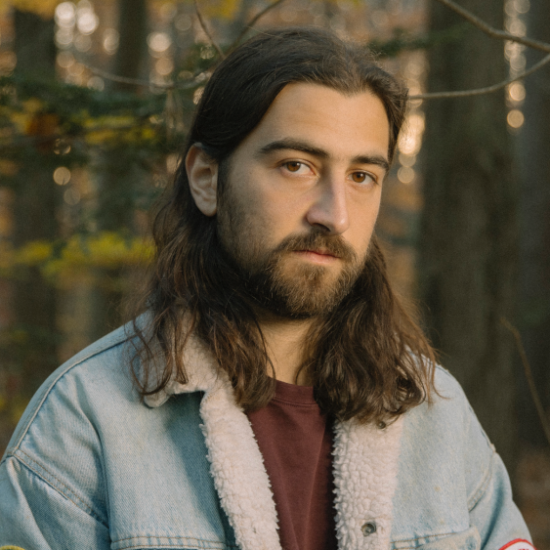
At first, Jaime Guevara’s version of “Hey There Delilah” sounds like just another cover of the Plain White T’s original. But some seconds in, an accordion enters the mix. Then, Guevara shifts his crooning from English to Spanish.
“¿Qué tal, Delilah?” he sings, interpreting the lyrics and feeling of the song that for a new audience. “Aquí estoy si te sientes sola.”
Suddenly, the song that was a hit in the mid- to late aughts has become a norteña, a ballad from a regional Mexican genre that relies heavily on accordions and other acoustic instruments.
Guevara, a Houston musician, and his EZ Band have created more than a dozen covers in norteña form, such as “Creep” by Radiohead and “Easy on Me” by Adele — and they’ve taken off.
The EZ Band’s rendition of “Hey There Delilah” has been played more than 1.5 million times on Spotify, and at least two million times on TikTok. The band’s version of “Santeria,” originally by Sublime, even drew notice from a fan account. And most recently, the band ventured into Swiftie land with a remake of Blank Space, from the “1989” album by Taylor Swift.
“It has kind of changed a lot of my life,” Guevara, 33, said in an interview, referring to the recent rising interest in the EZ Band and its album “Make it Norteño Vol. 1.” (Either norteña or norteño are used to describe artists, songs, music and awards in the genre, because nouns and adjectives have a gender in Spanish; the Grammy Awards, for instance, name a category for Best Norteño Album.)
Covers of different genres are not a new concept, of course. There have been Beatles songs made into polka music, and “Hotel California” has gotten the ukulele treatment. But the EZ Band’s songs are growing in popularity at a time when norteña music, and other regional Mexican genres like tumbados, are becoming more popular.
These blends of once-Top 40 and norteña music offer first- and second-generation Americans a way to connect with a musical heritage that they don’t always know or may have left behind. They also expose new audiences in the United States to the unique norteño sound.
The sound of norteña music has influences that date back to the 1840s, when Germans began settling in what is now southern Texas, according to Celestino Fernández, a retired sociology professor and consultant for the University of Arizona.
“They brought with them their music, and the accordion was a foundational instrument for the waltz and polka,” Dr. Fernández said. “Then the mexicanos, with the 12-string guitar, basically created música norteña.”
Guevara, who was born in Monterrey, Mexico, said his covers were the product of his background: He grew up listening to norteñas thanks to his father, who Guevara said played music on buses for tips in Mexico. When he moved to Houston with his family, at age 9, he was exposed to new genres of music in a new language. Later, Guevara’s wife, who is from Minnesota, introduced him to more new music from the wide range of American pop.
“Me, growing up, it’s the generation that grew up here listening to all the music in English, but also have family that listen to norteño,” Guevara said. “I get a lot of comments where people say, ‘You’re putting my two worlds together.’”
For decades, norteña music has mostly been popular in the regions where it originated: northern Mexico, the U.S. Southwest and California. But in recent years, the genre has gained a newfound recognition thanks, in part, to the prominence of other Latino acts like Bad Bunny and Peso Pluma. Both have collaborated with norteña bands.
Since Peso Pluma collaborated earlier this year with the regional Mexican band Eslabon Armado on “Ella Baila Sola” (“She Dances Alone”), the song has reached No. 4 on the Hot 100, Billboard’s mainstream pop chart, and it has been played more than 380 million times on YouTube.
“I didn’t think it would ever reach the level it has gotten to,” Guevara said of the current interest in norteña music. “It is a little surprising to see it blow up as much as it has.”
Dr. Fernández said some of norteña’s rise could be attributed to the growth of the Latino population in the United States.
“I think what we’re seeing is there are more and more Mexican immigrants in the United States, particularly the Southwest, and people bring their culture with them,” he said. “Some of them have heard that music when they were kids in their homes, and maybe now they’re reconnecting to it.”
Catherine Ragland, a professor of ethnomusicology at University of North Texas, said she had noticed the interest in her own neighborhood. Teens who were once playing rap and reggaeton from their cars, she said, are now blasting regional Mexican music.
For immigrants who moved to the United States recently or at a young age, listening to more traditional music can be a way to connect to their culture, Dr. Ragland said.
“This is a way to feel more authentically Mexican and really connect with that,” Dr. Ragland said. “The more they go back to these older styles, the more you feel like you’re truly connected to something.”
But perhaps a more simple explanation for norteña music’s new popularity is that it’s catchy and easy to move to.
“Norteña music is dance music,” Dr. Fernández said. “When you have events, people like to dance — and Mexicans and Mexican Americans have a lot of events around.”
Across Mexico and parts of the United States, norteña bands are often hired to play at celebrations for baptisms, first communions, weddings and even funerals, Dr. Fernández said. In Houston, the EZ Band has played at bars, parties and, recently, a halftime show at a Major League Soccer match.
After discovering the EZ Band on social media, Juan Loya, director of multicultural marketing for the Houston Dynamo, reached out to the band and invited it to perform.
Mr. Loya, 45, grew up in Houston and said that the band’s music resonated with him because his parents came from Mexico, and he used to listen to norteña music at parties and other events. Mr. Loya said that he thought the largely Hispanic Dynamo fan base would enjoy it, too.
“Hearing it in a different lens or in a different flavor,” Mr. Loya said of the EZ Band’s norteña sound, “it’s definitely really impactful to me, and I think I’m not alone in that.”
Adriana Torres, 38, of Maryland, said that she learned about the EZ Band while scrolling through social media, and she was hooked to the sound.
“It immediately took me back years,” Ms. Torres said, adding that she grew up listening to norteñas and other Mexican genres.
“It really touches people like me who are Mexican Americans, but also everyone,” she said. “It exposes our music in that style.”













